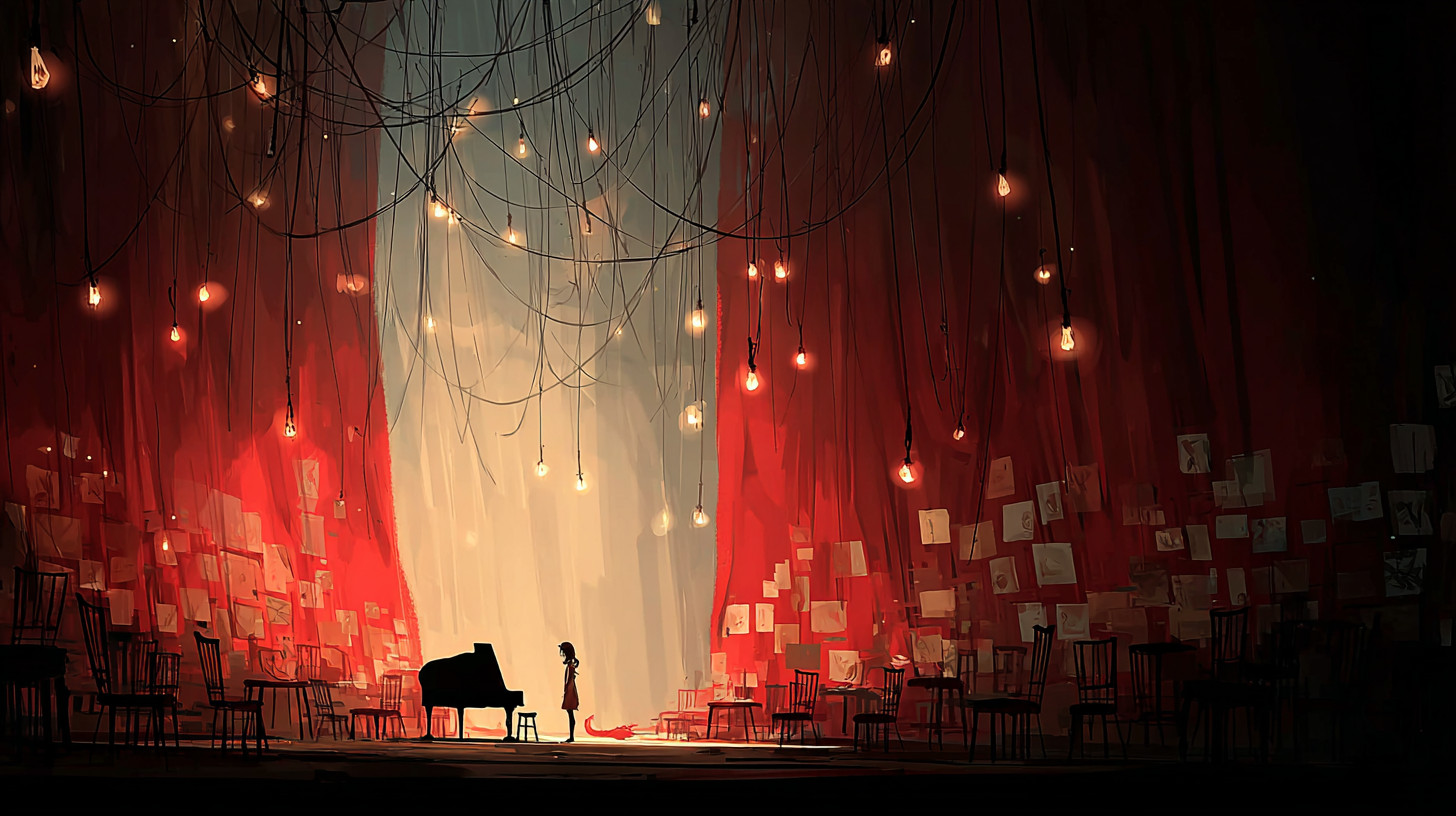A curtain is a big cloth that covers a window or stage.
カーテンは、窓やステージをおおう大きな布のこと。
以下は英単語 “curtain” に関するストーリー型学習コンテンツです。まずは大枠の意味を理解して最後の文章で確認しましょう。
主な意味(main meaning)
| 品詞 | 意味 | 発音記号 | 例文 |
|---|---|---|---|
| 名詞 | 窓や舞台を覆う布(カーテン) | /ˈkɜːr.tən/ | She opened the curtain to let the sunlight in. |
| 動詞 | カーテンで覆う、遮る | /ˈkɜːr.tən/ | The stage was curtained before the show began. |
語源(etymology)
「curtain」はラテン語の「cortina(丸い囲い)」から来ており、「何かを仕切るもの」や「囲うもの」というイメージが核にあります。
類義語(synonyms)
| 類義語 | 例文 |
|---|---|
| drape | The drape covered the entire wall. |
| blind | She pulled down the blind to block the sun. |
| screen | A white screen was set up for the presentation. |
| shade | He rolled up the shade to see outside. |
| veil | A thin veil covered the bride’s face. |
反義語(antonyms)
| 反義語 | 例文 |
|---|---|
| exposure | The room was in full exposure to the sun. |
| openness | The house design gives a sense of openness. |
コロケーション(collocations)
| コロケーション | 例文 |
|---|---|
| draw the curtain | Please draw the curtain before going to bed. |
| behind the curtain | Something was hidden behind the curtain. |
| curtain call | The actor came out for his curtain call. |
| lace curtain | She bought a new lace curtain for the kitchen. |
| stage curtain | The stage curtain rose slowly. |
2項表現(binomials)
| 表現 | 例文 |
|---|---|
| curtains and blinds | They sell curtains and blinds in many styles. |
| light and shade | The light and shade from the curtain made patterns on the floor. |
英語ストーリー(english story)
Title: Behind the Curtain
Mina worked as a receptionist in a small theater. Every day, she greeted visitors, handed out tickets, and made sure everything was in order. One evening, while she was checking the stage before the show, she noticed that the stage curtain had a small tear.
“Oh no,” she said. “The curtain needs to be fixed before the play starts!”
She quickly found a needle and thread backstage and began sewing. As she worked, she remembered a lesson from her mother: “Even when people only see the outside, the real story often happens behind the curtain.”
The show began on time, and nobody noticed the repair. After the performance, the actors took a curtain call, smiling as the audience clapped. Mina watched from the side and felt proud. Her small action had helped the show go on.
Later, a friend asked her, “Why do you love working in the theater?”
Mina replied, “Because it’s a place of light and shade, of dreams and effort. Even if I’m not on stage, I’m still part of the story.”
That night, she closed the doors, drew the curtain, and whispered to herself, “Tomorrow is another show.”
和訳
タイトル:カーテンの向こう側
ミナは小さな劇場で受付として働いていました。毎日、来客を迎え、チケットを渡し、すべてが整っているかを確認していました。ある晩、公演前にステージを確認していたとき、**舞台のカーテン(stage curtain)**に小さな破れがあるのを見つけました。
「大変、このカーテンを修理しなきゃ!」
彼女は急いで裏方で針と糸を見つけて縫い始めました。作業しながら、母の言葉を思い出しました。「人が見るのは表だけでも、本当の物語は**カーテンの後ろ(behind the curtain)**で起きているのよ。」
公演は予定通り始まり、誰も修理に気づきませんでした。上演後、俳優たちは**カーテンコール(curtain call)**を受け、観客の拍手に笑顔で応えました。ミナは袖からそれを見て、誇らしく感じました。自分の小さな行動が、公演を支えたのです。
あとで友達に「どうして劇場で働くのが好きなの?」と聞かれました。
ミナは答えました。「**光と影(light and shade)**があって、夢と努力がある場所だから。舞台に立たなくても、私はこの物語の一部なの。」
その夜、彼女は劇場のドアを閉め、カーテンを引き(drew the curtain)、そっとつぶやきました。「明日はまた別の物語。」
Q&A
- Q「curtain」と「drape」の違いは?
- A
どちらも窓などを覆う布を指しますが、「drape」はより重くて長く、装飾的な布を意味することが多いです。特に正式な場や劇場で使われる傾向があります。「curtain」はより一般的で、家庭の窓に使う普通のカーテンを指すことが多いです。
- Q「curtain」と「blind」の違いは?
- A
「blind」は布ではなく、横や縦のスラット(細長い板)で作られた「ブラインド(目隠し)」を指します。窓の光を調整するために上げ下げしたり回転させたりするのが特徴です。「curtain」は布で左右に開け閉めします。
- Q「curtain」と「screen」の違いは?
- A
「screen」は「仕切り」「スクリーン」「画面」など、光を映すためのものや空間を仕切るものを指します。例えばプロジェクター用の白い布や、病院で使うパーティションなども「screen」です。一方「curtain」は布で、主に光や視線を遮るためのものです。
- Q「curtain」と「shade」の違いは?
- A
「shade」は主に光を遮るためのロール式の布(ロールスクリーン)を指します。窓の上部から下ろす形です。「curtain」は横に開け閉めする布です。同じ遮光の目的でも形や動かし方が異なります。
- Q「curtain」と「veil」の違いは?
- A
「veil」は顔や頭を覆う薄い布で、花嫁や宗教的な用途に使われます。象徴的・装飾的な意味合いも強いです。「curtain」は日常的に使われる、窓などを覆う布であり、用途や場所が大きく異なります。
- Q「curtain」と「exposure(露出)」はどう反対なの?
- A
「curtain」は何かを隠したり覆ったりする役割があり、「exposure」は何かを外にさらすことを意味します。つまり、カーテンで隠すのとは反対に、光や視線にさらすのが「exposure」です。
- Q「curtain」と「openness(開放)」はどう反対なの?
- A
「curtain」が閉じることで空間や視線を遮るのに対し、「openness」は開けっぴろげで何も隠さない状態を意味します。心理的・物理的な「開放感」としても使われるため、概念としての反対語になります。
- Q「draw the curtain」と「behind the curtain」の違いは?
- A
「draw the curtain」は「カーテンを開ける・閉める」という動作を指します。一方、「behind the curtain」は「カーテンの後ろで」=「舞台裏で」「人に見えないところで」といった意味で使われます。
- Q「curtain call」とは何?「curtain」との関係は?
- A
「curtain call」は演劇などで舞台が終わったあと、俳優たちがもう一度出てきて観客の拍手に応える場面のことです。「curtain(幕)」が一度閉じた後に再び開くことから、この名前がついています。
- Q「lace curtain」と普通の「curtain」の違いは?
- A
「lace curtain」はレース素材のカーテンで、薄くて透け感があり、光を完全には遮りません。主に装飾や目隠しのために使われます。通常の「curtain」はもっと厚手で、遮光や防音の役割が強いです。
- Q「curtains and blinds」はどう違う?
- A
この表現では、「curtains(布製の横開きカーテン)」と「blinds(スラット式の上下に動かすブラインド)」の両方が家の窓に使われるアイテムとして並列に紹介されています。素材や開け方が異なります。
- Q「light and shade」はどういう意味で使われる?「curtain」との関係は?
- A
「light and shade」は直訳で「光と影」ですが、比喩的に「明暗」「良い面と悪い面」「複雑さ」を表す表現です。ストーリーや芸術、人生などに使われます。カーテンが光を遮ったり通したりする役割を持つため、間接的に関係しています。



コメント